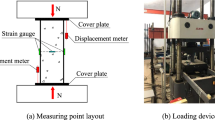Abstract
The dynamic behaviour of normal strength concrete-filled steel tubes (CFT) at elevated temperatures up to 800 °C under axial impact loading was experimentally studied by using a newly developed spilt Hopkinson pressure bar (SHPB) together with an electrical furnace. The effects of high temperature, impact velocity, steel ratio and slenderness ratio on the impact behaviour of CFT at elevated temperatures were experimentally studied. The stress and strain time history curves of the tested specimens were recorded to analyze the impact behaviour of CFT at elevated temperatures. The failure modes and the effects of the experimental parameters on the impact resistance of CFT are discussed. The test results showed that normal strength concrete-filled steel tube at elevated temperatures had a more excellent impact resistance in the paper than that described in Huo et al. (2009). A simplified calculation method was updated by introducing the reasonable dynamic increase factor model of hot concrete to reasonably assess the impact resistance of CFT at elevated temperatures.






















Similar content being viewed by others
References
Watstein D (1953) Effect of straining rate on the compressive strength and elastic properties of concrete. ACI J Proc 49(4):729–744
Goldsmith W, Polivka M, Yang T (1966) Dynamic behaviour of concrete. Exp Mech 6(2):65–79
Soroushian P, Choi KB, Alhamad A (1986) Dynamic constitutive behavior of concrete. ACI J Proc 83(2):251–259
Chen ZY, Luo JQ, Pan XW (1986) Behaviour of concrete-filled steel tubular columns under axial rapid loading. Tsinghua University technical reports TR 4 of Research Laboratory of Earthquake and Blast Resistant Engineering: behaviour of reinforced concrete structural members subjected to impulsive loads 1986. Tsinghua University Press, Beijing (in Chinese)
Prichard SJ, Perry SH (2000) The impact behavior of sleeved concrete cylinders. Struct Eng 78(17):23–27
Xiao Y, Shan JH, Zheng Q, Chen BS, Shen YL (2009) Experimental studies on concrete filled steel tubes under high strain rate loading. J Mater Civil Eng (ASCE) 21(10):569–577
Han LH, Zhao XL, Yang YF et al (2003) Experimental study and calculation of fire resistance of concrete-filled hollow steel columns. J Mater Civil Eng (ASCE) 129(3):346–356
Huo JS, Zheng Q, Chen BS, Xiao Y (2009) Tests on impact behaviour of micro-concrete-filled steel tubes at elevated temperatures up to 400 °C. Mater Struct 42(10):1325–1334
Jia B, Tao JL, Li ZL et al (2009) Dynamic mechanical performance of concrete at elevated temperatures. In: The 4th international conference on protection of structures against hazards, Beijing, pp 189–193
GB50204-2002 (2002) Code for acceptance of constructional quality of concrete structures GB50204-2002. Beijing (in Chinese)
Bischoff PH, Perry SH (1991) Compressive behaviour of concrete at high strain rates. Mater Struct 24(4):425–450
Davies EDH, Hunter SC (1963) The dynamic compression testing of solids by the method of the split Hopkinson pressure bar. Mech Phys solids 11(3):155–179
Li QM, Meng H (2003) About the dynamic strength enhancement of concrete-like materials in a split Hopkinson pressure bar test. Int J Solids Struct 40(2):343–360
ACI Committee 318 (2005) Building code requirements for structural concrete (ACI 318-05) and commentary (318R-05). American Concrete Institute, Farmington Hills (MI), 430
Kolsky H (1949) An investigation of the mechanical properties of materials at very high rates of loading. Proc Phys Soc Lond B 62(11):676–700
Lindholm US (1964) Some experiments with the split Hopkinson pressure bar. J Mech Phys Solids 12(5):317–335
ABAQUS (2006) ABAQUS 6.6, theory manual and users manual. HKS-Hibbitt, Karlsson & Sorensen Inc, Pawtucket
Lie TT, Irwin RJ (1990) Evaluation of fire resistance of reinforced concrete beam-columns with rectangular cross-section. NRC-CNRC Internal Report, No. 601, Ottawa (Canada)
Huo JS, Huang GW, Xiao Y (2009) Effects of sustained axial load and cooling phase on post-fire behaviour of concrete-filled steel tubular stub columns. J Constr Steel Res 65(8–9):1664–1676
European Committee for Standardization (CEN) (1993) Eurocode 3: design of steel structure. Part 1.2: general rules—structural fire design. ENV 1993-1-2 2005, London
Han LH, Zhao XL, Tao Z (2001) Tests and mechanics model of concrete-filled SHS stub columns, columns and beam-columns. Steel Compos Struct Int J 1(1):51–74
Elfahal MM, Krauthammer T, Ohno T et al (2005) Size effect for normal strength concrete cylinders subjected to axial impact. Int J Impact Eng 31(4):461–481
CEB (1988) Concrete structures under impact and impulsive loading. Bulletin d’Information No. 187, Comité Euro-International du Béton, Lausanne, France
Malvar LJ (1998) Review of static and dynamic properties of steel reinforcing bars. ACI Mater J 95(5):609–616
Li W, Guo ZH (1993) Experimental investigation on strength and deformation of concrete under high temperature. Chin J Build Struct 14(1):8–16 (in Chinese)
ECCS,European recommendations for the fire safety of steel structure, Elsevier, Amsterdam 1983
He YM, Huo JS, Xiao Y (2011) Experimental study on dynamic behavior of concrete at elevated temperatures. Adv Sci Lett 4(3):1128–1131
Yu Q (2011) Experimental study on SHPB impact behaviors of plain concrete at elevated temperatures. Master thesis 2011, Hunan University, Changsha, Hunan
Acknowledgments
The research described in this paper was conducted at the Center for Integrated Protection Research of Engineering Structures (CIPRES), Ministry of Education Key Laboratory of Building Safety and Efficiency of the Hunan University, under the supports of the National Natural Science Foundation project (Project No. 50778069), the Program for New Century Excellent Talents in University (NCET-11-0123) and the Program for Changjiang Scholars and Innovative Research Team Project (Project No. IRT0619).
Author information
Authors and Affiliations
Corresponding author
Rights and permissions
About this article
Cite this article
Huo, J., He, Y. & Chen, B. Experimental study on impact behaviour of concrete-filled steel tubes at elevated temperatures up to 800 °C. Mater Struct 47, 263–283 (2014). https://doi.org/10.1617/s11527-013-0059-8
Received:
Accepted:
Published:
Issue Date:
DOI: https://doi.org/10.1617/s11527-013-0059-8




